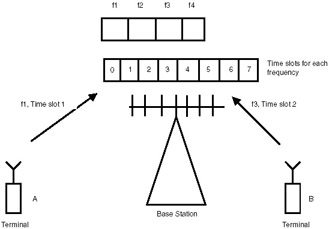8.4 FDMATDMA
|
| < Day Day Up > |
|
8.4 FDMA/TDMA
In many radio systems, a combination of FDMA and TDMA is used. For example, in cellular mobile communication systems, each base station is given a set of frequencies, and each frequency is divided into time slots to be shared by different terminals.
The concept of FDMA/TDMA is illustrated in Figure 8.7. The base station is assigned four frequencies: f1 to f4. Each frequency is in turn shared in TDMA mode with eight time slots. Terminal A is assigned time slot 1 of frequency f1. The base station keeps allocating the time slots in f1 until all are exhausted. Then it allocates time slots in f2 and so on. After some time, terminal B wants to make a call. At that time, time slot 2 in frequency f3 is free and is allocated to terminal B.

Figure 8.7: FDMA/TDMA
In FDMA/TDMA, a pool of frequencies is shared by a number of terminals. In addition, each frequency is shared in different time slots by the terminals. FDMA/TDMA is used in mobile communication systems and satellite communication systems.
The combination of FDMA and TDMA increases the capacity of the system. In the above example, 32 subscribers can make calls simultaneously using the eight time slots of four frequencies.
|
| < Day Day Up > |
|
EAN: 2147483647
Pages: 313